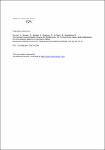The German Environmental Survey for Children (GerES IV): Reference values and distributions for time-location patterns of German children
Conrad, André
Seiwert, Margarete
Hünken, Andreas
Quarcoo, David
Schlaud, Martin
Groneberg, David
Children's time-location patterns are important determinants of environmental exposure and other health-relevant factors. Building on data of the German Environmental Survey for Children (GerES IV), our study aimed at deriving reference values and distributions for time-location patterns of 3–14-year-old German children. We also investigated if GerES IV data are appropriate for evaluating associations with children's health determinants by linking them to data of the National Health Interview and Examination Survey for Children and Adolescents (KiGGS). Parents reported on the time their children usually spend at home, in other indoor environments, and outdoors. This information was characterized by statistical parameters, which were also calculated for different strata concerning socio-demography and the residential environment. Consequently, group differences were evaluated by t-tests and univariate ANOVA. Reference distributions were fitted to the time-location data by a Maximum Likelihood approach to make them also useable in probabilistic exposure modeling. Finally, associations between data on the children's physical activity as well as body weight and their outdoor time were investigated by bivariate correlation analysis and cross tabulation. On daily average, German children spend 15 h and 31 min at home, 4 h and 46 min in other indoor environments, and 3 h and 43 min outdoors. Time spent at home and outdoors decreases with age while time spent in other indoor environments increases. Differences in time-location patterns were also observed for the socio-economic status (SES) and immigration status. E.g., children with a high SES spend 24 min less outdoors than low SES children. Immigrants spend on daily average 20 min more at home and 15 min less outdoors than non-immigrant children. Outdoor time was associated with parameters of the residential environment like the building development. Children living in 1- or 2-family houses spend more time outdoors than children living in building blocks (3 h 48 min vs. 3 h 29 min). Physical activity correlates with outdoor time. For children with diminished age-specific outdoor time, a higher prevalence of obesity was observed (odds ratio: 3.2, 95% CI: 1.5–7.1). GerES IV provides a compilation of current time-location reference values and distributions on German children. This data hint to substantial differences in time-location patterns within the population to be considered in environmental health risk assessment.
No license information

